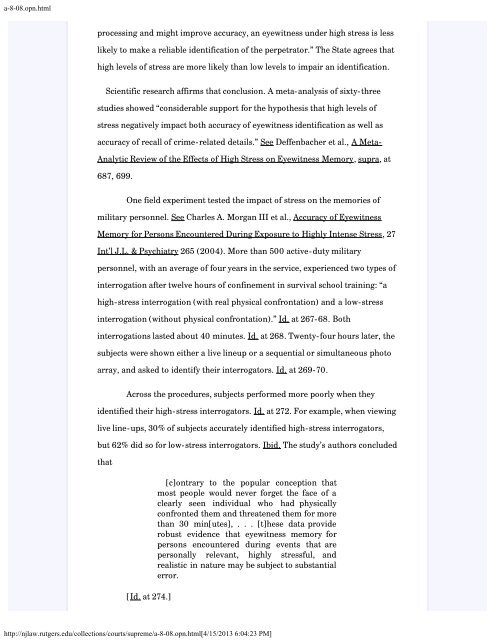State v. Henderson and the New Model Jury Charges - New Jersey ...
State v. Henderson and the New Model Jury Charges - New Jersey ...
State v. Henderson and the New Model Jury Charges - New Jersey ...
You also want an ePaper? Increase the reach of your titles
YUMPU automatically turns print PDFs into web optimized ePapers that Google loves.
a-8-08.opn.html<br />
processing <strong>and</strong> might improve accuracy, an eyewitness under high stress is less<br />
likely to make a reliable identification of <strong>the</strong> perpetrator.” The <strong>State</strong> agrees that<br />
high levels of stress are more likely than low levels to impair an identification.<br />
Scientific research affirms that conclusion. A meta-analysis of sixty-three<br />
studies showed “considerable support for <strong>the</strong> hypo<strong>the</strong>sis that high levels of<br />
stress negatively impact both accuracy of eyewitness identification as well as<br />
accuracy of recall of crime-related details.” See Deffenbacher et al., A Meta-<br />
Analytic Review of <strong>the</strong> Effects of High Stress on Eyewitness Memory, supra, at<br />
687, 699.<br />
One field experiment tested <strong>the</strong> impact of stress on <strong>the</strong> memories of<br />
military personnel. See Charles A. Morgan III et al., Accuracy of Eyewitness<br />
Memory for Persons Encountered During Exposure to Highly Intense Stress, 27<br />
Int’l J.L. & Psychiatry 265 (2004). More than 500 active-duty military<br />
personnel, with an average of four years in <strong>the</strong> service, experienced two types of<br />
interrogation after twelve hours of confinement in survival school training: “a<br />
high-stress interrogation (with real physical confrontation) <strong>and</strong> a low-stress<br />
interrogation (without physical confrontation).” Id. at 267-68. Both<br />
interrogations lasted about 40 minutes. Id. at 268. Twenty-four hours later, <strong>the</strong><br />
subjects were shown ei<strong>the</strong>r a live lineup or a sequential or simultaneous photo<br />
array, <strong>and</strong> asked to identify <strong>the</strong>ir interrogators. Id. at 269-70.<br />
Across <strong>the</strong> procedures, subjects performed more poorly when <strong>the</strong>y<br />
identified <strong>the</strong>ir high-stress interrogators. Id. at 272. For example, when viewing<br />
live line-ups, 30% of subjects accurately identified high-stress interrogators,<br />
but 62% did so for low-stress interrogators. Ibid. The study’s authors concluded<br />
that<br />
[Id. at 274.]<br />
[c]ontrary to <strong>the</strong> popular conception that<br />
most people would never forget <strong>the</strong> face of a<br />
clearly seen individual who had physically<br />
confronted <strong>the</strong>m <strong>and</strong> threatened <strong>the</strong>m for more<br />
than 30 min[utes], . . . [t]hese data provide<br />
robust evidence that eyewitness memory for<br />
persons encountered during events that are<br />
personally relevant, highly stressful, <strong>and</strong><br />
realistic in nature may be subject to substantial<br />
error.<br />
http://njlaw.rutgers.edu/collections/courts/supreme/a-8-08.opn.html[4/15/2013 6:04:23 PM]
















